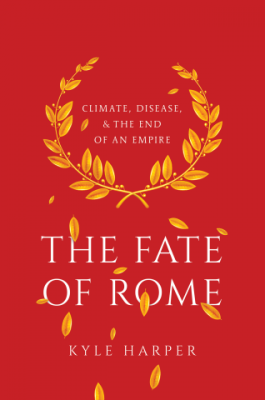Did climate change seal Rome's fate?

ROME - Gibbon thought that the Roman Empire collapsed under its own weight, Friedrich Nietzsche suggested that Christianity softened it and there was a Russian scholar who blamed the lead in the Roman water pipes for poisoning the population.
Kyle Harper claims that climate change and new diseases, such as smallpox, were more decisive in the Empire’s demise than factors such as corruption, poor leadership or the barbarians pressure on the frontiers.
In other words, he sets socio-political history in an environmental context which suggests it is relevant to us because, like the Roman empire, we may have illusions about our control over Nature.
For Harper, a classics professor at the university of Oklahoma, the Empire was an early example of globalisation with third century Rome having a population over a million, a dozen other substantial cities and lively trade, which were ideal conditions for the spread of lethal germs.
He traces the successive devastating diseases and relates them to the evolution of the climate.
A first major plague occurred during the latter part of the second century AD, then another in the middle of the third century and, most devastatingly of all, in the mid 6th century with recurrences almost until the 8th.
What were the diseases? There was no idea of germs but contemporaries left descriptions of the symptoms which indicate smallpox and bubonic plague as two of the main culprits. Moreover the ability to extract and sequence ancient DNA from archaeological material is one of several recent advances which have brought greater knowledge about the ancient world. With technological progress, stones, bones and genomes are yielding information at an accelerating rate.
Harper writes precisely, with a knack for effective clinchers and quaint items of information – for instance, that Emperor Constantine donated 775 pounds of pepper yearly to St. Peter’s basilica... The history of germs, some of which evolved nastily about this time, is more frightening but less engaging than that of people but he tries to counter this by introducing figures such as Galen, “antiquity’s greatest doctor.”
He is interesting on the relation between epidemics and religion – he says that Christianity emerged strongly after Christians in Rome gave exemplary help to plague victims while recently-founded Islam made inroads in the Middle East against the Eastern Roman empire when it was weakened by plague.
The non-specialist reader has to take on trust the impressive range of evidence Harper supplies which ranges from information on various disease–bearing rodents to tables indicating the sizes of femurs in the different Italian regions over more than a thousand years BC to AD.
But the reader may query the weight he gives to the each of the factors involved in the buckling of the empire. Harper points out that many more deaths were caused by diseases than by battles, citing the loss of 20,000 troops outside Adrianopole in 378 AD which was much less than were killed in a plague of that period. But the psychological impact of the defeat may have been greater because the disease was attributed to divine anger whereas the defeat, the first inflicted by barbarians on the ‘invincible’ Roman legions, was ominous and due to human mistakes.
Admittedly the huge losses caused by bubonic plague, which like the Black Death in the mid-14 century, in some countries killed half the population, would have had massive effects as it diminished the work force and recruits for the army, setting in action a calamitous cycle.
It is an important book with a sobering message about the primacy of the environment in the fate of the ancient Roman civilisation - and perhaps of ours.
Kyle Harper, The Fate of Rome: Climate, Disease and the End of Empire, Princeton University Press, 417pp, rrp. £27.95
Desmond O’Grady is the author of Reshaping Rome and other books about the city.


